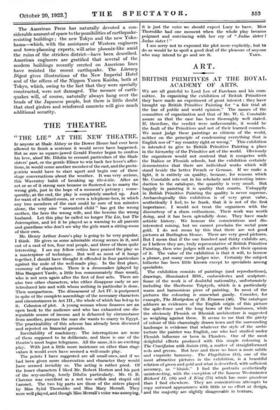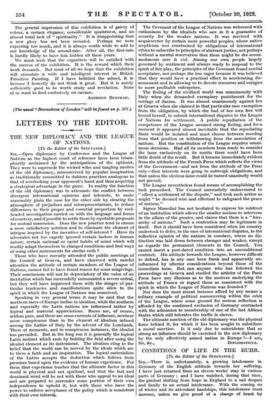ART.
BRITISH PRIMITIVES AT THE ROYAL ACADEMY OF ARTS.
WE are all grateful to Lord Lee of Fareham and his com- mittee. In organizing the exhibition of British Primitives they have made an experiment of great interest ; they have brought up British Primitive Painting for " a fair trial at the bar of public and world opinion." The names of the committee of organization and that of Mr. W. G. Constable assure us that the case has been thoroughly well stated. If, therefore, the verdict were unfavourable, it would be the fault of the Primitives and not of their learned counsels. We must judge these paintings as citizens of the world, neither on the principle of condemning everything that is English nor of " my country right or wrong." This exhibition is intended to give to British Primitive Painting a place in the hierarchy of the Primitive art of the world. Obviously the organizers would not contend that it competes with the Italian or Flemish schools, but the exhibition certainly demonstrates that there are individual works which will stand beside the better French or German. If we make a fight, it is entirely on quality, because, for reasons which Mr. Constable sets out in his scholarly and interesting intro- duction to the catalogue, the quantity is very small. But happily in painting it is quality that counts. Unhappily in British Primitive Painting the quality is never supreme. Archaeologically this exhibition is of very great value, aesthetically I feel, to be frank, that it is not of the first importance. I would not treat the organizers with the discourtesy of a sham enthusiasm. Their work was worth doing, and it has been splendidly done. They have made artistic history. We honour the conscientious and dis- interested mining, but we cannot proclaim the metal pure gold. I do not mean by this that there are not good pictures at Burlington House. There arc very good pictures. But I mean that if the one hundred and thirty exhibits arc, as I believe they are, truly representative of British Primitive Painting, then wise judges will not greatly alter their opinion of it. The value of the exhibition is that it will, to borrow a phrase, put many more judges wise. Certainly the subject hitherto has been little known except to specialists among specialists.
The exhibition consists of paintings (and reproductions), drawings, illuminated MSS., embroideries and sculpture. Some of the work is of doubtful nationality, unfortunately including the Sherborne Triptych, which is a particularly warm and harmonious piece of painting. In most of the pictures the colouring is somewhat gaudy. Consider, for example, The Martyrdom of St. Erasmus (40). The catalogue adduces as evidences of the English origin of this picture the spile-fence and the long bows of the huntsmen, while the obviously Flemish or Rhenish architecture is suggested as weighing against these. It seems to me that the gaiety of colour of this charmingly drawn town and the surrounding landscape is evidence that whatever the style of the archi- tecture the painter was English, one who had studied under Flemish influence or been in Flanders. One of the most delightful effects produced with this simple colouring is The Crucifixion with Saints (10), a matter of straightforward reds and greens. But here and there we have a more subtle and exquisite harmony. The Flagellation (54), one of the most attractive pictures in the exhibition, is a beautiful relation of green and gold and what is described, with► sufficient accuracy, as " bluish." I find the portraits aesthetically
uninteresting, with the exception of the famous Westminster Richard II. (30) and A King (73) which has more grandeur than I find elsewhere. They are conscientious attempts to copy outward appearances with little or no effort at design, and the majority are slightly disagreeable in texture.
The general impression of this exhibition is of gaiety of colour, a certain elegance, considerable quaintness, and an almost total lack of " spirituality." It is disappointing that a new glory has not been revealed. Perhaps we were expecting too much, and it is always worth while to add to our knowledge of the second-rate. After all, the first-rate is hardly likely to have lain hidden all these years.
We must wish that the organizers will be satisfied with the success of the exhibition. It is the reward which their work demands. But most of all we hope that the exhibition will stimulate a wide and intelligent interest in British Primitive Painting. If I have belittled the school, it is because I honestly do not think it great. But it is surely sufficiently good to be worth study and revelation. None .of us want to feed exclusively on caviare.
ANTHONY BERTRAM.











































 Previous page
Previous page